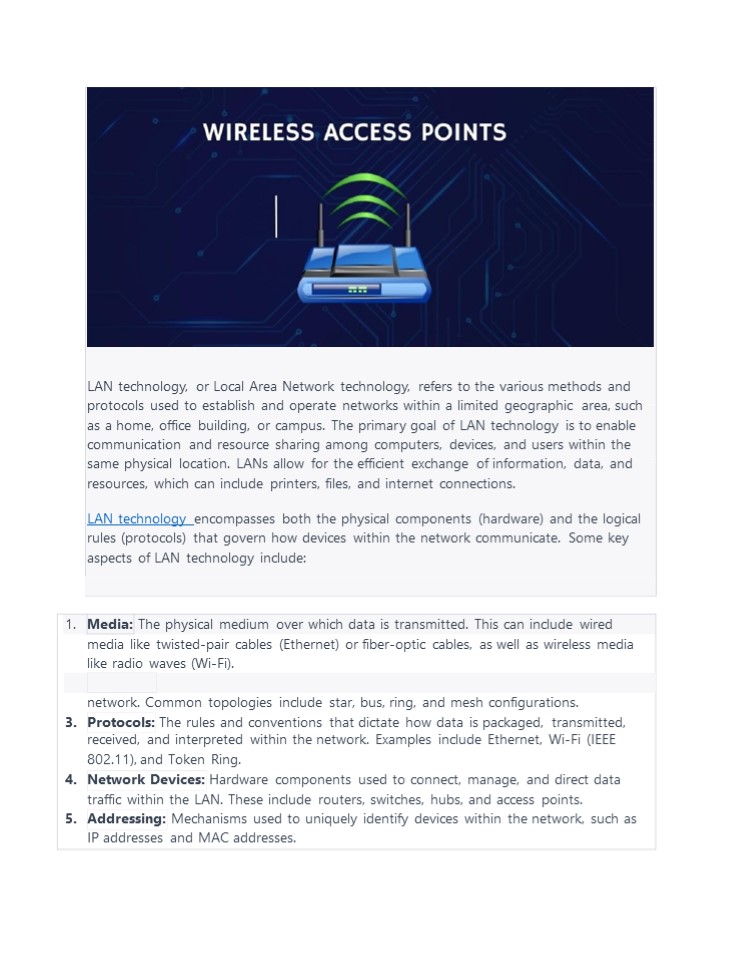Lan Technology PowerPoint PPT Presentation
Title: Lan Technology
1
LAN technology, or Local Area Network
technology, refers to the various methods and
protocols used to establish and operate networks
within a limited geographic area, such as a
home, office building, or campus. The primary
goal of LAN technology is to enable
communication and resource sharing among
computers, devices, and users within the same
physical location. LANs allow for the efficient
exchange of information, data, and resources,
which can include printers, files, and internet
connections. LAN technology encompasses both the
physical components (hardware) and the logical
rules (protocols) that govern how devices within
the network communicate. Some key aspects of LAN
technology include
1. Media The physical medium over which data is transmitted. This can include wired
media like twisted-pair cables (Ethernet) or fiber-optic cables, as well as wireless media like radio waves (Wi-Fi). Topology The arrangement of devices and how they are interconnected within the network. Common topologies include star, bus, ring, and mesh configurations. Protocols The rules and conventions that dictate how data is packaged, transmitted, received, and interpreted within the network. Examples include Ethernet, Wi-Fi (IEEE 802.11), and Token Ring. Network Devices Hardware components used to connect, manage, and direct data traffic within the LAN. These include routers, switches, hubs, and access points. Addressing Mechanisms used to uniquely identify devices within the network, such as IP addresses and MAC addresses. media like twisted-pair cables (Ethernet) or fiber-optic cables, as well as wireless media like radio waves (Wi-Fi). Topology The arrangement of devices and how they are interconnected within the network. Common topologies include star, bus, ring, and mesh configurations. Protocols The rules and conventions that dictate how data is packaged, transmitted, received, and interpreted within the network. Examples include Ethernet, Wi-Fi (IEEE 802.11), and Token Ring. Network Devices Hardware components used to connect, manage, and direct data traffic within the LAN. These include routers, switches, hubs, and access points. Addressing Mechanisms used to uniquely identify devices within the network, such as IP addresses and MAC addresses. media like twisted-pair cables (Ethernet) or fiber-optic cables, as well as wireless media like radio waves (Wi-Fi). Topology The arrangement of devices and how they are interconnected within the network. Common topologies include star, bus, ring, and mesh configurations. Protocols The rules and conventions that dictate how data is packaged, transmitted, received, and interpreted within the network. Examples include Ethernet, Wi-Fi (IEEE 802.11), and Token Ring. Network Devices Hardware components used to connect, manage, and direct data traffic within the LAN. These include routers, switches, hubs, and access points. Addressing Mechanisms used to uniquely identify devices within the network, such as IP addresses and MAC addresses.
2
6. Data Transmission Rates The speed at which data can be sent and received within the
network. This is often measured in bits per second (bps) or its multiples (Mbps, Gbps, etc.). network. This is often measured in bits per second (bps) or its multiples (Mbps, Gbps, etc.). network. This is often measured in bits per second (bps) or its multiples (Mbps, Gbps, etc.).
Common LAN technologies include Ethernet and
Wi-Fi, which are widely used in both residential
and business settings. Ethernet uses physical
cables to connect devices, while Wi-Fi employs
wireless radio signals. LANs are typically used
to create a foundation for sharing resources,
accessing the internet, facilitating
communication, and supporting various
applications within a localized environment. It's
important to note that LAN technology is just one
aspect of networking. There are also Wide Area
Networks (WANs), Metropolitan Area Networks
(MANs), and other types of networks that cater
to larger geographical areas and different
communication requirements.

